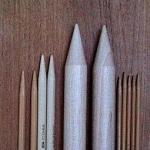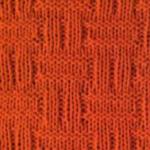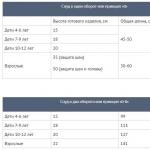Step by step papier mache. Making the simplest papier-mâché
Papier-mâché in art, handicrafts is used as a material for the manufacture of sculptures, puppets, bowls for fruit, dolls and other objects. You can make a variety of crafts for the interior. The papier-mâché surface can be easily painted in the desired color, it can also be decorated.
How to make papier-mâché products
To make a lot of papier-mâché, you will need unnecessary newspapers or other paper, glue, water. Mix the glue with water in a 2/1 ratio. Newspapers should be cut into strips two centimeters wide or torn into small pieces. Combine newspapers and glue solution, mix until a homogeneous mixture with a spoon or a bristle brush.
If you use stationery glue to make the material, keep in mind that difficulties may lie in wait when painting the molded product. The paint may refuse to stick to the surface. It is best to prime the product with artistic whitewash or acrylic primer before painting, and then cover it with paint.
Some products look better with a smooth surface. When pasting a form with strips of paper, it is not always possible to achieve perfect smoothness. But the procedure for leveling the surface is not as difficult as it might seem - you just need to be patient with it.
How to get a smooth papier-mâché product surface
First, you need to align the most noticeable pits by gluing small pieces of paper there. Do this until the surface looks more or less even. The product must be dried, after which the surface is treated with fine-grained sandpaper. Perform processing in circular light movements, pressing should be as light as possible. Wipe up paper fibers periodically with a rag. Thickly coat the treated surface with glue and dry well to make the top layer stronger. This procedure can be repeated several times to increase the strength of the top layer. After that, you can start painting, inlaying or decorating the surface in another way.
For slight roughness, cover the surface with several coats of PVA glue or use an aerosol varnish for cars.
If you want to paint the product, after the painting procedure is over, it is better to cover the surface with varnish - in two or three layers. The varnish is suitable for both nitro and furniture, make sure that the paint does not "float". The product processed in this way will be smooth and shiny.

The word "papier-mache" is translated from French as "chewed paper" or "torn paper". This technique first appeared in France. Papier-mâché was used to make trays, toys, snuff boxes, candlesticks, and even decorative moldings.
1:928 1:933There are two ways to create papier-mâché products.
1:1040The first is sculpting from a formable mass, consisting of soft paper and adhesive.

The second is gluing torn paper in layers, this type is also called waving.

The papier-mâché technique is not difficult at all, but it requires accuracy and patience. The process of making a conceived little thing can take several days due to the long drying of the material.
But the time spent will not be wasted, because as a result, you can create a wide variety of things with your own hands, such as decorative elements of the interior, caskets, piggy banks, figurines, masks, dolls, rattles and much more.

Papier-mâché is often combined with decoupage technique. Such an alliance makes it possible to create truly real masterpieces.

The first method is sculpting from the mass
Usually, newspaper sheets are used to make the mass, but this is not important, toilet paper, paper towels can be used.
We tear or cut newspaper sheets into small pieces, put them in a deep vessel and fill them with water. It is best to use a mixer, grinding in small portions. But you can do it on your own, for this, fill the torn paper with hot water and leave it to soak for about 3 hours.
Then knead with your hands until a homogeneous mass is obtained. Excess water must be drained through a sieve, and a mixture of glue and paste must be added to the resulting thickening. Knead until it starts to stick a little to your hands.

If not used in one go, it can be stored in a cool place for several days, it cannot be frozen. During storage, the mass may become liquid, in this case squeeze it out and add glue.
The mass is prepared with glue and paste, because when using only glue, it is difficult to sculpt, and one paste does not provide the necessary strength. Fine sawdust can be added to increase the strength.

The paste for the mass can be prepared as follows:
mix flour and water in a ratio of 1: 3, mix thoroughly so that there are no lumps.
Put on fire, and stirring continuously, bring to a boil.
Then remove from heat and let cool.
The paste is stored in the refrigerator for several days, tightly wrapped in plastic wrap.
You need to paint the product with tempera, alkyd or oil paint. Gouache and watercolors are not suitable due to the fact that they get dirty and washed off.

For greater durability of gouache, a little PVA glue is added to it. Cover the painted product with colorless varnish. Before painting, the product must be sanded and primed.
The second method is waving (sticking pieces of paper)

Wrapping is pasting a prepared form with pieces of paper. The paper should be soft, and newspaper sheets are also suitable for this.
The most ideal option is mixed pasting: apply the first layer of colored or white paper, grease the surface with glue, then cover with the second, using paper of a contrasting color or newspaper scraps.

This is used in order not to get confused in the number of layers. In any case, the last layer is necessarily made of white paper. It is necessary to make at least 8-10 layers. Dry every two coats before applying the next two. It is necessary to ensure that the pieces of paper when pasting slightly overlap each other, lie flat and do not wrinkle.
Under no circumstances should the paper for wrapping be cut with scissors., exclusively tear with hands into small pieces. In this case, the edges are thin and well smoothed in the finished product.
Depending on how the papier-mâché was made, machining can be internal (pasted over from the inside) and external (external)... If you expect that the form to be pasted will remain inside the product, grease it with glue before working. But in case of subsequent extraction, cover the form with petroleum jelly or greasy cream.

Wallpaper glue is very suitable for wrapping, which can be replaced with a paste of your own preparation.
The paste is brewed in the same way as in the case of working with mass for papier-mâché, but you can also make it as follows:
the starch is diluted with water at room temperature and stirred until sour cream is thick.
Continuing to stir, boiling water is added in small portions until a transparent, thick liquid similar to jelly is obtained.
After cooling down, the paste is ready to work.
It cannot be stored for a long time, it is better to cook fresh every time.
Also, casein glue is used for work, which is sold in hardware stores.

Small details are completed with a mixture of scraps of paper and glue. It must be remembered that when dried, they greatly decrease in size. If this happens, then after complete drying, cover the parts with torn paper to the required size.
The product is dried at room temperature for about two days.
Drying on the battery is contraindicated, as it may crack.

The finished, completely dried workpiece must be removed from the mold and well processed with sandpaper, trying to achieve an even surface. Then prime. For this, it is best to use a water-based or latex-based primer. The primer is applied with a flat brush. Let the previous one dry before applying the next coat.

The finished item is painted and varnished, as well as the item made from the mass for papier-mâché.
Sometimes, for the completeness of comfort and style, our house lacks a single detail. Wall clocks, paintings, figurines - all this will certainly complement the design of the home. Today, specialty stores are rich in a selection of interior decorations. But nothing can replace handmade jewelry. After all, who else but the owner himself knows what exactly is lacking in his house. Today we will make a beautiful Chinese style newspaper using papier-mâché technique.
Note: The papier-mâché technique dates back to the 2nd century in China. Translated from French "papier mâché" means torn or chewed paper. In ancient times, various things were made from this plastic mass, from kitchen utensils to helmets, and then varnished. This simple master class with step-by-step photographs will introduce you to this technique, and a plate of papier-mâché from newspapers will decorate your interior with your own hands.
To make a plate using the papier-mâché technique, we need:
- Newspaper sheets;
- Plate;
- PVA glue or paste;
- Plate with water;
- Paints;
- Brush.
Master class "How to make a plate of papier-mâché from newspapers"
1) First, let's tear the newspaper sheets into small pieces. But not very small, let them be 2 cm each. Now take the saucer and turn it upside down.
We will take one piece of newsprint and moisten them in a previously prepared plate of water. Moisten so that the shreds are completely wet. We cover the plate with moistened scraps, as if gluing them. We cover only the outer part of the plate. We put it so that the newspaper scraps go beyond the edges of the plate. Then we will cut them.
After we lay out the first layer, you need to coat the plate with glue. You can use ordinary PVA, or you can make a paste. In this case, we will use PVA. We coat the plate with a thin layer along the entire diameter.
Now add another layer of newspaper scraps on top, also dipped in water. After we lay out the second layer, you need to coat the plate with glue again. Then again apply a layer of scraps dipped in water.
After the third layer is ready, you need to coat the plate with glue again and let it rest a little.
When the plate is slightly dry, put a layer of newspaper scraps dipped in water on top again. So add two more layers. That is, after the plate has dried, three layers are again put. It is imperative to coat with glue after each layer so that after drying the shreds do not puff up and do not leave. After the sixth layer is laid out, grease it again with glue and leave the plate to dry.
The more layers you apply, the thicker and denser your plate will be. Better to overlay nine layers.
When you have laid out all the layers, you need to leave the plate to dry thoroughly. Leave it overnight.


2) When our newspaper plate is completely dry, we trim the edges with scissors, focusing on the real plate that was pasted over. We take out the real one from the newspaper plate and put it away. Now let's move on to the design. We take gouache. We paint our plate well with white. We paint until the text from the newspaper scraps becomes invisible.

3) Since we will be making a plate in the Chinese style, after the white gouache dries, paint over the bottom of the plate and the border in red. We paint in several layers. During staining, it is advisable to use as little water as possible so that the white gouache does not start to wash off and mix with the red one.

4) Now take the black color and paint over part of the bottom and border of the plate. We also put the paint in several layers.

5) Now we will draw a sakura branch. To do this, change the brush to a thinner one. First, draw the branch itself.

6) Now let's draw arbitrary branchings.

Papier-mâché is an ancient art that has not lost its popularity. Try this simple creativity and find a source for new masterpieces in it!
Papier-mâché is a simple technique for making bulky items using paper and paste. Even with the advent of various plastics (super plastics), papier-mâché does not lose its popularity, remaining indispensable for some types of creativity (for example, masks). Take a short excursion into the history of this unusual technique and find out what options for its use exist, how to make papier-mâché with your own hands, and how this activity will be useful.
History of paper art
The papier-mâché technique is time-tested, because its history goes back several thousand years! The ancient Egyptians made death masks using layers of papyrus interspersed with adhesive. In Persia, multi-layered paper was used to make decorative items, including chests and cups. Often, thin metal plates were applied over the paper layer.
The strength of papier-mâché products with a large number of layers was noticed back in ancient China - they began to use this technique for the production of armor and shields that could protect a warrior not only from an arrow, but also from a sword strike.

Repeated coating with natural varnishes added additional strength to the material. In addition, in Japan and China, ceremonial masks, decorative elements for a military costume, home decor items (boxes, vases) and even buttons were made from this material.
Often, the surface of the products was covered with a glossy varnish, and thus luxurious-looking things were obtained from a relatively cheap material. In India, papier-mâché could be found in any craft market in the form of richly ornamented household items.
Since the 17th century, papier-mâché began to be actively used in France, and then in England, in puppetry - this technique was the best way to reproduce the delicate features of puppet faces. The high strength of the material was a big advantage. Unlike porcelain, the finished papier-mâché product was not fragile, and was also much lighter than wood.
In the 18th century, papier-mâché became an inexpensive alternative to architectural stucco and carved wood, later this technique was even used for the manufacture of furniture elements (for example, chair backs) and church utensils.
To this day, papier-mâché is widely used in film production and theater for the manufacture of props (dummies of various things: weapons, dishes, jewelry, interior items, imitation of reliefs in the landscape or architectural structures), overhead elements for makeup (noses, chins), stage details costume (hats, masks). 
Minimum funds and maximum benefits
Papier-mâché is one of the few types of creativity that will be of interest to almost everyone, because there are a lot of options for products made of glued paper, and the process of working in this technique does not require artistic training or certain knowledge. Despite the fact that paper is used for this type of creativity, it has nothing to do with other paper hobbies, weaving from paper tubes.
The advantages of this hobby are obvious:
- it does not require material costs;
- he does not need a large workplace;
- you can do without special skills;
- technology is an extremely simple process that even a preschool child can master;
- a wide creative spectrum (making dolls, masks, figurines, boxes, items for decorations, Christmas tree decorations, shades);
- suitable for making items of any size;
- finished products are highly durable and do not require special care.

What you need for classes and first crafts
As already noted, papier-mâché is a very economical form of creativity. The main thing that is needed for papier-mâché is thin paper and glue (PVA, carpentry, stationery, gelatinous or starch paste). There are two fundamentally different versions of this technique:
- pieces of paper are glued in layers on the finished form;
- an elastic mass is prepared from paper and paste, from which an object is formed.
Everyone can include this hobby in the list of their hobbies; success awaits only those who do not like to quit what they started. Qualities that will be useful in working with papier-mâché:
- perseverance;
- accuracy;
- a little fantasy.
Features of layer-by-layer technique and work process
The first option (from pieces) is suitable for making masks, doll heads, figurines, boxes. The surface of the finished products lends itself to grinding, so it is very easy to achieve perfect smoothness. The whole process of work can be divided into several stages.
First step
Prepare thin paper (newspaper works well). To do this, you can cut or tear it into pieces, their size depends on the intended size of the product - for small works it can be 1x1 cm, for large ones up to 4x4, 4x10 cm.Torn paper will make the surface of the product smoother than cut.
Prepare the form on which the paper will be glued. To do this, you can take both a ready-made object and one sculpted from plasticine or clay (for example, a doll's head).
If you take a ready-made object as the basis for papier-mâché, remember that to obtain a volumetric shape, you will need to cut the already-finished papier-mâché into two halves to get the base shape, and then glue them. Therefore, the base may be damaged when cut. For a spherical shape, you can take a balloon, which at the end of the work can be removed through a previously left hole in the layers of paper.
To make ready-made papier-mâché easy to separate from the base (both finished and molded), it is recommended to grease the form with petroleum jelly or wrap it with cling film before applying the first layer of paper.
Second phase
Paste the form with layers of paper. The number of layers depends on the desired thickness and strength - the minimum amount is 4–5, the maximum is not limited, but already with 15 layers, the wall thickness of the product will be about 0.5–0.7 cm, so there is usually no point in making more layers than this amount. 
To evenly cover the form with paper, it is convenient to alternate layers of different colors - so it will be clear when to start a new one.
Stage Three
Dry the product well (within 24 hours) and remove it from the mold. If an incision is required to remove it, it is convenient to make it with a sharp paper knife. After removing the mold, you need to glue pieces of paper on the inside of the product along the cut so that half of the piece goes beyond the cut, then grease them with glue and attach the second half of the product.
You also need to glue the joint line of the halves on the outside with two layers of paper and, for strength, cover the entire shape with another layer of papier-mâché (if further staining is expected, then it is better with a layer of white paper). 
A well-dried product can be sanded with fine-grained emery paper.
You can paint papier-mâché with any paint, but it is best to take acrylic - it will not be erased from the mold and dries quickly. If desired, papier-mâché is opened with varnish.
Pulp modeling
The second version of papier-mâché (from paper pulp) is suitable for the formation of finished products by the method of simple sculpting or sculpting on a frame. By the way, the very name of the technique is translated from French as "chewed paper". There are a lot of recipe options for preparing the mass, and after a few tests you will find your own optimal ratio of ingredients.
Usually it is done this way: soak newsprint, cardboard from boxes or egg trays, or toilet paper in warm water, leave it for several hours, periodically kneading it with your hands (you can put it on the stove to keep the water warm).
After soaking, the mass is carefully squeezed out and crushed with a blender or in a meat grinder (a more laborious option is rubbed through a sieve). Next, glue is added to the mass and kneaded until the homogeneous elastic mass ceases to stick to the hands. 
The formed product dries completely in 2-3 days - it should not be dried on a battery, as this can lead to cracks. The dried mass becomes hard and very light. It can also be sanded and painted in the same way as or.
Useful activity for pleasure
As already noted, completely different types of products can be made using the papier-mâché technique, this is an excellent way to make both decorative works and things for practical use in the home. With this technique, you can simulate more expensive materials such as metal, stone, or ceramics.

Cat's house


Working with papier-mâché calms, helps to focus on the process and take a break from everyday worries, develops creative thinking. Starting with simple and common products, you will quickly move on to realizing your own creative ideas. 

Step-by-step workshops for beginners
To make it easier for you to move from plans and doubts to actions, our needlewomen have prepared step-by-step instructions with a photo. Taking master classes as a basis, you will quickly master the papé-mâché technique and learn how to create your own masterpieces worthy of imitation.




Papier-mâché is a paper pulp from which you can create a huge variety of crafts. In this article we will look at: how to make papier-mâché crafts with your own hands.
There are 3 ways to make papier-mâché: first way implies the use of a template (the shape of any object). Pieces of wet paper are glued onto the template in layers. Second way consists in creating paper dough from which the figurine is molded. Third way- This is the gluing of plates of hardboard. It is worth noting that in some crafts, all methods are used. To extend the life of the craft, it is covered with transparent manicure varnish.
Papier-mâché plate

You will need: plate, newspaper sheets, brush, PVA glue, a bowl of water, gouache, scissors, transparent manicure varnish.
Master Class

The papier-mâché Chinese plate is ready! I recommend watching the video master class!
Papier-mâché cup

You will need: cardboard, scissors, newspaper sheets, scotch tape, pva glue, brush, paints, transparent manicure varnish.
Master Class

Papier-mâché heart

You will need: roll of toilet paper, cold water, small towel, bowl, small saucepan, 2 tablespoons of flour, wire, pva glue, clear nail polish.
Master Class

Follow the step-by-step master classes and then everything will work out. Much depends on the decoration of the craft. The figurine can be simple, but a successfully chosen color and decorations will make a masterpiece out of it. Experiment with your own hands!






